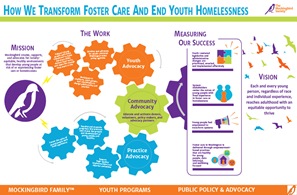Back in 1904 Rand McNally printed the first automobile road map. A sprawling map of New York City and vicinity, it launched what became a staple in every car’s dashboard. Today, maps are no less important—whether we use them via smart phones, GPS, or good old-fashioned paper, they still serve to guide us to a destination.
Pressure Test Your Theory of Change
Do you have the right theory of change? Use this set of criteria to pressure test it to determine whether you're on track to reach your goals.
Download the checklist [PDF] >>
As the leader of a mission-driven organization, you’re also focused on a destination—achieving your nonprofit organization’s intended impact: the results your organization will accomplish, for whom, and in what time frame. And your organization’s theory of change provides a conceptual road map for how your organization aims to achieve its impact. Both provide critical inputs to your organization’s overall strategy. (Read more about intended impact and theory of change in Zeroing in on Impact.)
How do I write a theory of change?
Developing a theory of change takes thoughtful, intentional work. You will need to be able to explain how your intended impact will actually happen; in other words, the cause-and-effect logic by which you will convert organizational and financial resources into the desired social results. To get started, try articulating specific and realistic answers to these questions:
-
What are the underlying needs and key characteristics of the population we want to serve?
-
What are the specific activities we believe we should offer to that population? For how long? How often?
-
Through what sequence of causes and effects do we believe these actions will result in the impacts we aspire to achieve?
-
What staff, skills, systems, and tools do we need?
-
What external context (e.g., regulatory environment, actions of other organizations) is required to facilitate the desired effects?
Articulating your organization’s theory of change is most powerful when done in partnership with your key stakeholders—senior leaders, staff, board, and client/community. Engaging these constituents on the viability and scope of your organization’s theory of change will ensure that it has relevance and effectiveness with the communities you seek to impact. This can happen in myriad ways: sharing a document at a town hall meeting, engaging stakeholders in round-table discussions, or 1-on-1 meetings. What’s important is that you seek the input you need to refine your theory of change, and that your senior leaders and other key stakeholders understand and agree with the core elements of how your organization will make the change you aim for happen.
How can using a theory of change benefit your nonprofit?
A good theory of change allows a nonprofit to make strategic decisions about how to use its time, talent, and dollars to generate the maximum social returns. In addition to helping you make better decisions, it can also build a more cohesive organization. When Mockingbird Society Board President Hickory Gateless transitioned to the role of deputy director for the Seattle-based youth advocacy organization, he recalls a lack of consistency around how stakeholders in the organization understood and communicated the mission.

"I remember clearly that one of our first conversations…was, 'what do we do?' and 'why do we do it?'" Gateless said. Surprisingly, everyone had a different answer. "In answering these questions, it was clear to us that we would all need to have a shared language and shared understanding of what our theory of change was to achieve our mission as an organization." (Read more in “How the Mockingbird Society Crafted Its Theory of Change.”) After refreshing their theory of change, Gateless said “[A] major benefit was that it helped us communicate better with funders, donors, and the community.”
So, besides aligning on a path to social impact, a theory of change provides several other benefits. It can help an organization:
- Make trade-offs among different programs, activities, and/or investments
- Design new programs, where needed, or evaluate and improve existing programs
- Understand how the activities and programs your organization pursues relate to one another, so that the whole is greater than the sum of the parts
- Understand how your programs and approaches sit within a wider environmental context and mesh with other organizations' activities
- Communicate internally and externally about your approach to impact and the unique value you add
So, is it time set your organization’s GPS on a new theory of change? The time you and your team devote to developing a theory of change won’t only help you get to your goals, but also make sure you don’t get lost along the way.
Achieve Strategic Clarity
A well-crafted theory of change is crucial to achieving your organization’s mission. Get clear on who you serve and how, so you can focus your resources and have the greatest impact possible. Achieving Strategic Clarity, Bridgespan’s online, team-based program, is designed to help nonprofit leaders like you tackle these important questions together in a flexible setting. Learn more >>
Download Pressure Test Your Nonprofit's Theory of Change
Please fill out the form below to download the checklist. We use the information we collect to help us improve our content and to inform our funders about the impact of our work. We will never share your personal information with any third party without your permission.If you'd rather not share your information, you can download a PDF of the checklist by clicking here.


